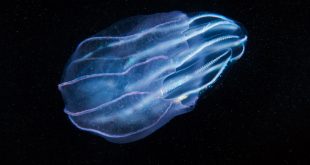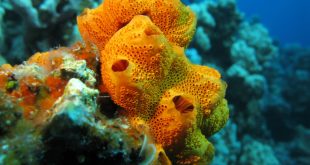Sponge cells are loosely arranged in a gelatinous matrix called mesohyl, or mesenchyme. The mesohyl is the connective tissue of sponges; in it are found various fibrils, skeletal elements, and ameboid cells. The absence of tissues or organs means that all fundamental processes must occur at the level of individual cells. Respiration and excretion occur by diffusion in each cell and, in freshwater sponges, excess water is expelled via contractile vacuoles in archaeocytes and choanocytes.
The visible activities and responses in sponges, other than propulsion of water, are alterations in shape, local contractions, propagating contractions, and closing and opening of incurrent and excurrent pores. Incurrent pores may close in response to heavy sediment in the water or other conditions that reduce the efficiency of feeding. The most common response is closure of the oscula. These movements are very slow, but the fact that there are responses of the whole body in animals that lack organization above the cellular level is puzzling.
Apparently excitation spreads from cell to cell by an unknown mechanism; suggested mechanisms include mechanical stimuli and signaling molecules, possibly hormones. Electrical communication across the syncytial tissue of hexactinellid sponges has been demonstrated, but nothing similar has been found in cellular sponges. Some zoologists point to the possibility of coordination by means of substances carried in the water currents, and others have tried, not very successfully, to demonstrate the presence of nerve cells. Although nerve cells have not been found, several other types of cells do occur.

Choanocytes Choanocytes, which line flagellated canals and chambers, are ovoid cells with one end embedded in mesohyl and the other exposed. The exposed end bears a flagellum surrounded by a collar. The collar is composed of adjacent microvilli, connected to each other by delicate microfibrils, forming a fine filtering device for straining food particles from water. The beating flagellum pulls water through the sievelike collar and forces it out through the open top of the collar. Particles too large to enter the collar become trapped in secreted mucus and slide down the collar to the base where they are phagocytized by the cell body. Larger particles have already been screened out by the small size of the dermal pores and prosopyles. Food engulfed by the cells is passed to a neighboring archaeocyte for digestion. Thus, digestion is entirely intracellular, so there is no extracellular gut cavity. Choanocytes also have a role in sexual reproduction.
Archaeocytes Archaeocytes are ameboid cells that move in the mesohyl and perform a number of functions. They can phagocytize particles at the pinacoderm and receive particles for digestion from choanocytes. Archaeocytes apparently can differentiate into any of the other types of more specialized cells in the sponge. Some, called sclerocytes, secrete spicules. Others, called spongocytes, secrete the spongin fibers of the skeleton, and collencytes secrete fibrillar collagen. Lophocytes secrete large quantities of collagen but are distinguishable morphologically from collencytes.
Pinacocytes The nearest approach to a true tissue in sponges is arrangement of the pinacocyte cells of the pinacoderm. A true tissue is a grouping of cells specialized for one function; a true tissue epithelium consists of a layer of specialized cells resting on a basal membrane. Pinacocytes are thin, flat, epithelial-like cells that cover the exterior surface and some interior surfaces of a sponge. Some are T-shaped with their cell bodies extending into the mesohyl. A layer of pinacocytes does not constitute an epithelium because a basal membrane is lacking in sponges. However, the pinacoderm is sufficiently specialized to be called an incipient tissue by some.
Pinacocytes may take up food particles by phagocytosis at the sponge surface. Pinacocytes are somewhat contractile and help to regulate surface area of a sponge. Some pinacocytes are modified as contractile myocytes, which are usually arranged in circular bands around oscula or pores, where they help regulate rate of water flow.
Useful External Links
- Parazoa: The Sponges by University of MIAMI
- Sponge Structure and Function by CK-12
- Describe the different cell types and their functions in sponges by Vaia
 EazyBio: Educate, Elevate, Empower EazyBio: Educate, Elevate, Empower
EazyBio: Educate, Elevate, Empower EazyBio: Educate, Elevate, Empower





